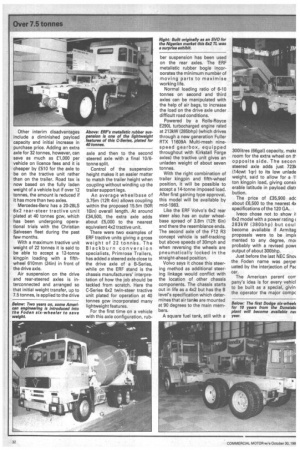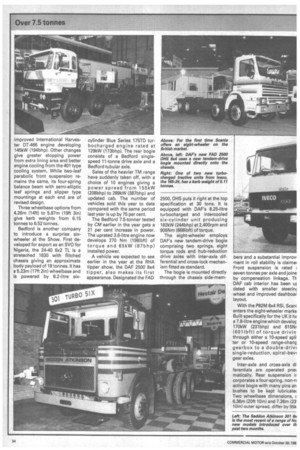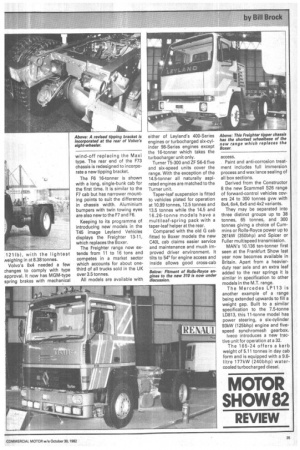Discernible increase in market demand
Page 23

Page 24

Page 25

Page 26

Page 27

If you've noticed an error in this article please click here to report it so we can fix it.
k SMALL BUT significant imirovement in trade and a subsepent movement of goods is low beginning to show and this vas reflected in operator inerest on the stands at the Motor ;how (which closes on Sunday wening).
Some operators who have )een postponing the replacenent of vehicles would suffer if leet values sunk so low that rade-in values would prohibit )uying new.
Of these operators who have nore work than existing rehicles can handle but are un;Lire of long-term demand are urning to rental companies to ulfil their immediate needs.
Two of Britain's biggest manuacturers are claiming a slow but )ositive increase in market lemand and one predicted a rise in sales of about 10 per cent by the end of 1983.
As in recession, during a period of recovery it is the premium tractive market which is most responsive. In an effort to give a lead on weights, three manufacturers introduced rearsteer tractive units at this year's Show plated for operation at 38 tonnes.
Certainly few of the manufacturers I spoke to believed that Armitage recommendations of 44 tonnes gross would be a starter. Anyway, the Government threw this idea out last year. • As for 40 tonnes they believe that only a few operators would want to take advantage of about one tonne payload after the extra equipment had been added to what will be needed to operate at 38 tonnes.
Having three of the five axles needed for proposed operation at 38 tonnes on the tractive unit has some merit for operating at 32.5 tonnes in the intervening period. Such units are able to operate with existing semitrailer equipment.
With a ratio of two trailers or more to each tractive unit in many fleets and taking into account that, on average, trailers have two to three times the life of the prime mover, it is a solu
tion that will appeal to many, at least for the short term. If the
weights go above 32 tonnes gross then the pin position would need to be moved to give a longer front overhang and increased loading on the fifth wheel although it is most probable that this would lead to swing clearance problems between the rear of the tractive unit and semi-trailer landing legs. Other interim disadvantages include a diminished payload capacity and initial increase in purchase price. Adding an extra axle for 32 tonnes, however, can save as much as £1,000 per vehicle on licence fees and it is cheaper by £510 for the axle to be on the tractive unit rather than on the trailer. Road tax is now based on the fully laden weight of a vehicle but if over 12 tonnes, the amount is reduced if it has more than two axles.
Mercedes-Benz has a 20-28LS 6x2 rear-steer tractive unit plated at 40 tonnes gcw, which has been undergoing operational trials with the Christian Salvesen fleet during the past few months.
With a maximum tractive unit weight of 22 tonnes it is said to be able to accept a 12-tonne kingpin loading with a fifthwheel 610mm (24in) in front of the drive axle.
Air suspension on the drive and rear-steered axles is interconnected and arranged so that initial weight transfer, up to 7.5 tonnes, is applied to the drive axle and then to the second steered axle with a final 10/6tonne split.
Control of the suspension height makes it an easier matter to match the trailer height when coupling without winding up the trailer support legs.
An average wheelbase of 3.75m (12ft 4in) allows coupling within the proposed 15.5m (50ft 10in) overall length. At around £34,500, the extra axle adds about £5,000 to the nearest equivalent 4x2 tractive unit.
There were two examples of ERF tractive units giving a gross weight of 22 tonnbs. The Blackburn conversion specialists, Primrose Trailers, has added a steered axle close to the drive axle of a B-Series, while on the ERF stand is the chassis manufacturers' interpretation of how the job should be tackled from scratch. Here the C-Series 6x2 twin-steer tractive unit plated for operation at 40 tonnes gcw incorporated many lightweight features.
For the first time on a vehicle with this axle configuration, rub ber suspension has been used on the rear axles. The ERF metalistic rubber bogie incorporates the minimum number of moving parts to maximise working life.
Normal loading ratio of 6-10 tonnes on second and third axles can be manipulated with the help of air bags, to increase the load on the drive axle under difficult road conditions.
Powered by a Rolls-Royce E290L turbocharged engine rated at 213kW (285bhp) (which drives through a new generation Fuller RTX 11609A Multi-mesh ninespeed gearbox, equipped throughout with Kirkstall Forge axles) the tractive unit gives an unladen weight of about seven tonnes.
With the right combination of trailer kingpin and fifth-wheel position, it will be possible to accept a 14-tonne imposed load. After first gaining type approval, this model will be available by mid-1983.
Like the ERF Volvo's 6x2 rear steer also has an outer wheelbase spread of 3.8m (12ft 6in) and there the resemblance ends. The second axle of the F12 R3 concept vehicle is self-tracking but above speeds of 30mph and when reversing the wheels are pneumatically locked in the straight-ahead position.
Volvo says it chose this steering method as additional steering linkage would conflict with the location of other chassis components. The chassis starts out in life as a 4x2 but has the B level's specification which determines that air tanks are mounted at 90 degrees to the main members. 3001itres (66ga1) capacity, mak( room for the extra wheel on th opposite side. The secon steered axle adds just 723k (14cwt 1qr) to its low unlade weight, said to allow for a 1! ton kingpin load, giving consic erable latitude in payload distr bution.
The price of £35,900 adc about £6,500 to the nearest 4x specifications of the 120 GA.
Iveco chose not to show i1 6x2 model with a power rating c 283kW (380bhp) but coul become available if Armitag proposals were to be implf mented to any degree, mol probably with a revised pow( output of about 300bhp.
Just before the last NEC Sho% the Foden name was perpe1 uated by the interjection of Pac car.
The American parent conpany's idea is for every vehicl
to be built as a special, givin, the operator the major compc
nent specification he asks for. Sandbach Engineering boasts a choice of wheelbases from the minimum practical to the legal maximum in one-inch increments.
The Paccar chassis system, incorporating high-tensile steelframe rails, extruded aluminium cross-members and forged aluminium gussets is claimed to have been proven worldwide. The high-tensile steel side-members have a yield strength of 758,450kW/sqm (110,000lb/ sqin), about twice as great as the material . used for current S104 and S106 models. The stronger material allows the side rails to be made slimmer, lighter, but stronger than before.
While retaining the composite construction cab now with rectangular head lamps, all other major components such as axles, transmission, steering, brakes, suspension wheels and' air cleaner, though not the 6LXCT Gardner engine, are new to the 6x4 5106 24-ton rigid. It is equipped with a Ritemixer 6-7cum capacity Concrete mixer/ agitator and is ready for the road at a lightweight 9.875 tonnes.
The chassis carries a warning that the chassis flanges must not be drilled. The angled mounting plates were bolted through the side-member. Assembly of the chassis uses the high tensile bolts and washers and avoids the use of welds and rivets throughout. • A 6x24-ton Dodge Commando 2 exhibited by Karrier Motors is a new vehicle to the range and the first British-built six-wheeler by Dodge for 10 years. The G24 with a 4.3m {14ft lin) wheelbase has the V8.540 Perkins engine rated at 126.7kW (170bhp) at 2,600rpm and 536Nm (396Ibft) of torque at 1,700rpm which gives a chassis cab weight of 6,175kg and sufficient payload to accommodate a 6cum (7.8cuyd) mixer or tipper body.
Its Hendrickson RT380 aluminium beam suspension incorporating semi-elliptical leaf springs combines with Easton single-speed axles to form the rear bogie which has an interaxle differential lock. Availability is predicted for mid-1983, by which time the details of a 5.1m
(16f1 83/4in) wheelbase model will also be announced.
While building of the light Trafic and Master ranges at the Dunstable plant is dependent upon Renault gaining a share of the British Telecom contract, manufacture of the Renault tractive units is planned to begin there by the end of next year.
Francois Zannotti, president of Renault Vehicles Industriels, intimated that his company would be prepared to introduce British content such as Rolls-Royce engines in R310 if that is what the market demands.
The JK 75 with its four-cylinder engine is to be type approved and with the 16-tonne GF151 will continue to be part of the overall Renault marketing programme.
Ford's traditional strength in the light and medium vans seg ments is further strengthened at the top of the new range now that the company has at last entered the 32-tonne tractive unit market.
Two engine options are available. The air-cooled Deutz allows the lower engine-cowl height and inclusion of a twin passenger seat inside the cab but like the alternative naturally aspirated 10.5-litre Perkins engine it has an installed output of 152kW (201bhp).
With the introduction of increased weights, this model would be extended to 34 tonnes.
One other lightweight tractive unit built specifically for the UK market by Mercedes is the 1621S plated for 34 tonnes but with a power output of just 150kW (210bhp).
Power is not in question for the Seddon Atkinson 301 trac tive unit powered by the new 10 litre Cummins engine. Designed as a lightweight producing 180kW (241bhp) at 2,100 and torque of 995NM (734Ibft) at 1,300 rpm, we can expect this new model to compete on equal terms with both middleweight and lightweight tractive units such as the Volvo F7, Scania and DAF 2500.
The 301 6x4 is the fourth new model from Seddon Atkinson in two months. It is powered by an improved International Harvester DT-466 engine developing 145kW (194bhp). Other changes give greater stopping power from extra lining area and better engine cooling from the 401 type cooling system. While two-leaf parabolic front suspension remains the same, its four-spring balance beam with semi-elliptic leaf springs and slipper type mountings at each end are of revised design.
Three wheelbase options from 4.26m (14ft) to 5.87m (19ft 3in) give kerb weights from 6.15 tonnes to 6.52 tonnes.
Bedford is another company to introduce a surprise sixwheeler at the Show. First developed for export as an SVO for Nigeria, the 24-40 6x2 TL is a streteched 1630 with flitched chassis giving an approximate body payload of 18 tonnes. It has a 5.23m (17ft 21n) wheelbase and is powered by 8.2-litre six
cylinder Blue Series 175TD turbocharged engine rated at 129kW (173bhp). The rear bogie consists of a Bedford singlespeed 11-tonne drive axle and a Bedford tubular axle.
Sales of the heavier TM range have suddenly taken off, with a choice of 10 engines giving a power spread from 1 5 5kW (208bhp) to 289kW (387bhp) and updated cab. The number of vehicles sold this year to date compared with the same period last year is up by 75 per cent.
The Bedford 7.5-tonner tested by CM earlier in the year gets a 21 per cent increase in power. The uprated 3.6-litre engine now develops 270 Nm (198Ibft) of torque and 6 5kW (8 7 bhp) installed power.
A vehicle we expected to see earlier in the year at the RHA tipper show, the DAF 2500 8x4 tipper, also makes its first appearance. Designated the FAD 2500, DHS puts it right at the top specification at 30 tons. It is equipped with DAF's 8.25-litre turbocharged and intercooled six-cylinder unit producing 182kW (244bhp) at 2,400rpm and 906Nm (668Ibft) of torque.
The eight-wheeler employs DAF's new tandem-drive bogie comprising two springs, eight torque rods and hub-reduction drive axles with inter-axle differential and cross-lock mechanism fitted as standard.
The bogie is mounted directly through the chassis side-mem
bers and a substantial improvi rnent in roll stability is claimet Front suspension is rated seven tonnes per axle and joine by compensation linkage. Th DAF cab interior has been ug dated with smaller steerin,c wheel and improved dashboar layout.
With the P82M 8x4 RSi, Scani enters the eight-wheeler marke Built specifically for the UK it ha a 7.8-litre engine which develop 170kW (231bhp) and 815Nr (601Ibft) of torque drivin through either a 10-speed spli ter or 10-speed range-chang gearbox to a double-driv( single-reduction, spiral-bev( gear axles.
Inter-axle and cross-axle di ferentials are operated pnet. matically. Rear suspension ir corporates a four-spring, non-rE active bogie with many pins an bushes to be kept lubricate( Two wheelbase dimensions, c 6.36m (20ft 10in) and 7.26m (23. 10in) outer spread, differ by 55k
1211b), with the lightest Neighing in at 8.38 tonnes. Volvo's 8x4 needed a few changes to comply with type approval. It now has MGM-type spring brakes with mechanical wind-off replacing the Maxi type. The rear end of the F73 chassis is redesigned to incorporate a new tipping bracket.
The F6 16-tonner is shown with a long, single-bunk cab for the first time. It is similar to the F7 cab but has narrower mounting points to suit the difference in chassis width. Aluminium bumpers with twin towing eyes are also new to the F7 and F6.
Keeping to its programme of introducing new models in the T45 image Leyland Vehicles displays the Freighter 13-11, which replaces the Boxer.
The Freighter range now extends from 11 to 16 tons and competes in a market sector which accounts for about onethird of all trucks sold in the UK over 3.5 tonnes.
All models are available with either of Leyland's 400-Series engines or turbocharged six-cylinder 98-Series engines except the 16-tonner which takes the turbocharger unit only.
Turner T5-300 and ZF 56-6 five and six-speed units cover the range. With the exception of the 14.5-tonner all naturally aspirated engines are matched to the Turner unit.
Taper-leaf suspension is fitted to vehicles plated for operation at 10.99 tonnes, 12.5 tonnes and 13.5 tonnes while the 14.5 and 16.26-tonne models have a multileaf-spring pack with a taper-leaf helper at the rear.
Compared with the old G cab .fitted to Boxer models the new C4OL cab claims easier service and maintenance and much improved driver environment. It tilts to 54° for engine access and inside allows good cross-cab access.
Paint and anti-corrosion treatment includes full immersion process and wax lance sealing of all box sections.
Derived from the Constructor 8 the new Scammell S26 range of forward-control vehicles covers 24 to 300 tonnes gvw with 8x4, 6x4, 6x6 and 4x2 variants.
They may be separated into three distinct groups up to 38 tonnes, 65 tonnes, and 300 tonnes giving a choice of Cummins or Rolls-Royce power up to 261kW (350bhp) and Spicer or Fuller multispeed transmission.
MAN's 10.136 ten-tanner first seen at the Frankfurt Show last year now becomes available in Britain. Apart from a heavierduty rear axle and an extra leaf added to the rear springs it is similar in specification to other models in the M.T. range.
The Mercedes LP113 is another example of a range being extended upwards to fill a weight gap. Built to a similar specification to the 7,5-tonne LD813, this 11-tonne model has power steering, a six-cylinder 93kW (125bhp) engine and fivespeed synchromesh gearbox.
lveco introduces a new tractive unit for operation at a 32.
The 165-24 offers a kerb weight of 5.11 tonnes in day cab form and is equipped with a 9.6litre 177kW (240bhp) watercooled turbocharged diesel.






































































